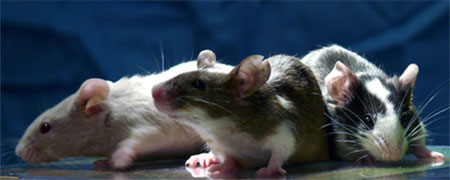Improved mouse model will accelerate research on potential ebola vaccines, treatments
Oct. 31, 2014
In the war against Ebola, one important hurdle has just been cleared – by a mouse.
A study published online Oct. 30 in Science magazine details how researchers from The University of North Carolina at Chapel Hill and their colleagues have developed a new genetic strain of mice that will significantly improve opportunities to test the initial efficacy of potential Ebola vaccines and treatments.

“We were able to produce a novel platform for rapidly developing new mouse models that replicate human disease outcomes when infected with Ebola,” said study co-author Dr. Ralph Baric.
The study, “Host genetic diversity enables Ebola hemorrhagic fever pathogenesis and resistance,” describes how these researchers solved an important challenge facing any team seeking remedies to Ebola, namely that mice lines traditionally used for pharmacological and medical research do not develop human disease phenotypes. The study’s co-authors were able to breed together genetic variants and successfully test a strain of mice to permit active research on potential Ebola vaccines and treatments in model systems that more accurately reflect the human condition.
“You can’t look for a cure for Ebola unless you have an animal model that mimics the Ebola virus disease spectra,” said study co-author Ralph Baric, PhD, professor of epidemiology at the UNC Gillings School of Global Public Health and UNC School of Medicine. “For the first time, we were able to produce a novel platform for rapidly developing new mouse models that replicate human disease for this virus, as well as other important emerging human pathogens.”
The study’s researchers tested different mouse strains from the “Collaborative Cross” for susceptibility to Ebola (a.k.a. EboV infection). The Collaborative Cross is a population of genetically diverse mice conceived of, bred and distributed by UNC to assess the role of genetic variation for a wide spectrum of medically relevant phenotypes.
“Since the Collaborative Cross was designed to better model human genetic diversity, it has proven to be a powerful system for studying how host genetic variation affects susceptibility to a number of emerging pathogens, including Ebola virus,” said study co-author Mark Heise, PhD, professor of genetics at UNC.
These studies, conducted at the National Institutes of Health (NIH) Rocky Mountain National Laboratory, demonstrated that host genetic variation directly led to different disease responses after infection. Importantly, these research groups were able to identify variation within a specific gene within these mice that controlled much of the variation in disease severity between individuals. Because this gene also is variable within the human population, these results point to a potential target for therapeutics in combating Ebola disease outcomes.
“Public perception of Ebola infection typically focuses on the high mortality rate following hemorrhagic disease,” said study co-author Martin Ferris, PhD, research assistant professor of genetics at UNC. “But Ebola actually produces a range of disease symptoms within infected individuals. During an outbreak, it is often difficult to assess the role that genetic variation plays in determining disease severity.”
This work is part of a larger collaboration between the UNC-Chapel Hill Department of Genetics, UNC’s Gillings School of Global Public Health, University of Washington Department of Microbiology, NIH Rocky Mountain National Laboratories, and the Oregon Health Sciences University to understand how genetic variation impacts susceptibility to a range of viral diseases.

